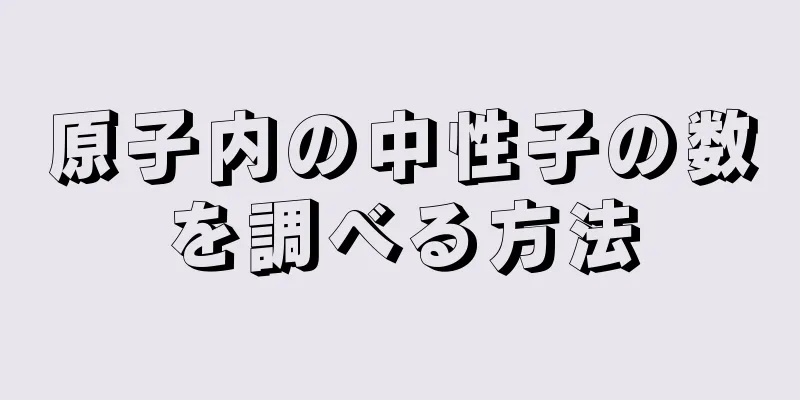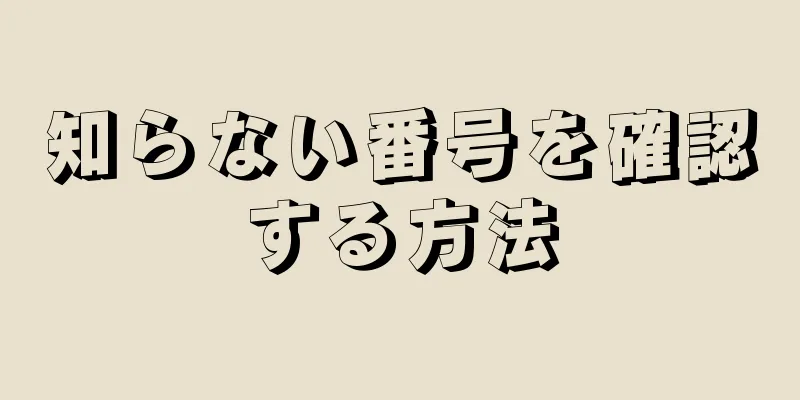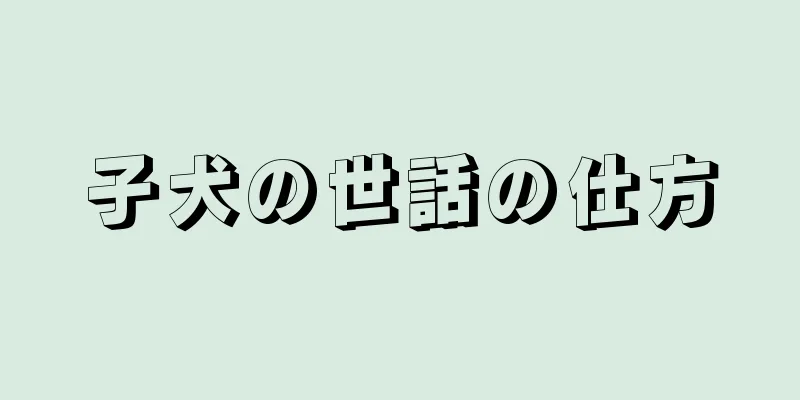|
同じ元素のすべての原子には同じ数の陽子が含まれていますが、中性子の数は異なる場合があります。特定の原子に含まれる中性子の数を知ることは、その原子がその元素の通常の原子であるか、または中性子の数が多いか少ないかの同位体であるかを判断するのに役立ちます。 [1] 原子内の中性子の数を決定することは難しくなく、実験を行う必要さえありません。通常の原子または同位体の中性子の数を計算するには、周期表を用意して、以下の手順に従ってください。 ステップ方法1方法1/2: 通常の原子内の中性子の数を調べる- {"smallUrl":"https:\/\/www.wikihow.com\/images_en\/thumb\/0\/05\/Find-the-Number-of-Neutrons-in-an-Atom-Step-1-Version-2.jpg\/v4-460px-Find-the-Number-of-Neutrons-in-an-Atom-Step-1-Version-2.jpg","bigUrl":"https:\/\/www.wikihow.com\/i mages\/thumb\/0\/05\/原子内の中性子の数を調べる-ステップ 1-バージョン 2.jpg\/v4-728px-原子内の中性子の数を調べる-ステップ 1-バージョン 2.jpg","smallWidth":460,"smallHeight":345,"bigWidth":728,"bigHeight":546,"licensing":"<div class=\"mw-parser-output\"><\/div>"} 1周期表で元素を見つけます。この例では、元素オスミウム (Os) を検索します。 6行目です。
- {"smallUrl":"https:\/\/www.wikihow.com\/images_en\/thumb\/f\/f0\/Find-the-Number-of-Neutrons-in-an-Atom-Step-2-Version-2.jpg\/v4-460px-Find-the-Number-of-Neutrons-in-an-Atom-Step-2-Version-2.jpg","bigUrl":"https:\/\/www.wikihow.com\/i mages\/thumb\/f\/f0\/Find-the-Number-of-Neutrons-in-an-Atom-Step-2-Version-2.jpg\/v4-728px-Find-the-Number-of-Neutrons-in-an-Atom-Step-2-Version-2.jpg","smallWidth":460,"smallHeight":345,"bigWidth":728,"bigHeight":546,"licensing":"<div class=\"mw-parser-output\"><\/div>"} 2元素の原子番号を見つけます。これは最もわかりやすい数字で、通常は元素記号の上に表示されます。 (実際、私たちが使用する表には、他の数字はありません。)原子番号は、原子内の陽子の数です。 Osは76番なので、陽子は76個あります。
- 元素内の陽子の数は変化せず、元素は本質的に陽子で構成されています。 [2]
- {"smallUrl":"https:\/\/www.wikihow.com\/images_en\/thumb\/0\/0b\/Find-the-Number-of-Neutrons-in-an-Atom-Step-3-Version-2.jpg\/v4-460px-Find-the-Number-of-Neutrons-in-an-Atom-Step-3-Version-2.jpg","bigUrl":"https:\/\/www.wikihow.com\/i mages\/thumb\/0\/0b\/Find-the-Number-of-Neutrons-in-an-Atom-Step-3-Version-2.jpg\/v4-728px-Find-the-Number-of-Neutrons-in-an-Atom-Step-3-Version-2.jpg","smallWidth":460,"smallHeight":345,"bigWidth":728,"bigHeight":546,"licensing":"<div class=\"mw-parser-output\"><\/div>"} 3原子の原子量を求めます。通常、シンボルの下に示されます。この表は、通常示される原子量ではなく、原子番号のみでラベル付けされていることに注意してください。オスミウムの原子量は190.23である。
- {"smallUrl":"https:\/\/www.wikihow.com\/images_en\/thumb\/4\/49\/Find-the-Number-of-Neutrons-in-an-Atom-Step-4-Version-2.jpg\/v4-460px-Find-the-Number-of-Neutrons-in-an-Atom-Step-4-Version-2.jpg","bigUrl":"https:\/\/www.wikihow.com\/i mages\/thumb\/4\/49\/Find-the-Number-of-Neutrons-in-an-Atom-Step-4-Version-2.jpg\/v4-728px-Find-the-Number-of-Neutrons-in-an-Atom-Step-4-Version-2.jpg","smallWidth":460,"smallHeight":345,"bigWidth":728,"bigHeight":546,"licensing":" class=\"mw-parser-output\"><\/div>"} 4原子量の小数部を切り捨てて、整数部、つまり原子質量を取得します。 190.23 は 190 と簡略化されるため、Os の原子量は 190 となります。
- 原子量は元素の同位体の平均であるため、通常は整数にはなりません。
- {"smallUrl":"https:\/\/www.wikihow.com\/images_en\/thumb\/f\/f0\/Find-the-Number-of-Neutrons-in-an-Atom-Step-5-Version-2.jpg\/v4-460px-Find-the-Number-of-Neutrons-in-an-Atom-Step-5-Version-2.jpg","bigUrl":"https:\/\/www.wikihow.com\/i mages\/thumb\/f\/f0\/Find-the-Number-of-Neutrons-in-an-Atom-Step-5-Version-2.jpg\/v4-728px-Find-the-Number-of-Neutrons-in-an-Atom-Step-5-Version-2.jpg","smallWidth":460,"smallHeight":345,"bigWidth":728,"bigHeight":546,"licensing":" class=\"mw-parser-output\"><\/div>"} 5原子質量から原子番号を引きます。ほとんどの原子の質量は陽子と中性子によって決まるため、陽子の数(原子番号)を引くと中性子の数の計算値が得られます。小数点以下の数字は、非常に小さな割合を占める電子の重さを表します。この場合、190(原子量)- 76(陽子数)= 114(中性子数)
- {"smallUrl":"https:\/\/www.wikihow.com\/images_en\/thumb\/4\/43\/Find-the-Number-of-Neutrons-in-an-Atom-Step-6-Version-2.jpg\/v4-460px-Find-the-Number-of-Neutrons-in-an-Atom-Step-6-Version-2.jpg","bigUrl":"https:\/\/www.wikihow.com\/i mages\/thumb\/4\/43\/Find-the-Number-of-Neutrons-in-an-Atom-Step-6-Version-2.jpg\/v4-728px-Find-the-Number-of-Neutrons-in-an-Atom-Step-6-Version-2.jpg","smallWidth":460,"smallHeight":345,"bigWidth":728,"bigHeight":546,"licensing":"<div class=\"mw-parser-output\"><\/div>"} 6この式を覚えておいてください。後で次の式を使用できます。広告する
方法2方法2/2: 元素の同位体の原子に含まれる中性子の数を調べる- {"smallUrl":"https:\/\/www.wikihow.com\/images_en\/thumb\/a\/a3\/Find-the-Number-of-Neutrons-in-an-Atom-Step-7-Version-2.jpg\/v4-460px-Find-the-Number-of-Neutrons-in-an-Atom-Step-7-Version-2.jpg","bigUrl":"https:\/\/www.wikihow.com\/i mages\/thumb\/a\/a3\/Find-the-Number-of-Neutrons-in-an-Atom-Step-7-Version-2.jpg\/v4-728px-Find-the-Number-of-Neutrons-in-an-Atom-Step-7-Version-2.jpg","smallWidth":460,"smallHeight":345,"bigWidth":728,"bigHeight":546,"licensing":"<div class=\"mw-parser-output\"><\/div>"} 1周期表で元素を見つけます。たとえば、炭素14同位体を探します。炭素14は炭素元素(C)なので、2行目の炭素を見つけます。
- {"smallUrl":"https:\/\/www.wikihow.com\/images_en\/thumb\/5\/51\/Find-the-Number-of-Neutrons-in-an-Atom-Step-8-Version-2.jpg\/v4-460px-Find-the-Number-of-Neutrons-in-an-Atom-Step-8-Version-2.jpg","bigUrl":"https:\/\/www.wikihow.com\/i mages\/thumb\/5\/51\/Find-the-Number-of-Neutrons-in-an-Atom-Step-8-Version-2.jpg\/v4-728px-Find-the-Number-of-Neutrons-in-an-Atom-Step-8-Version-2.jpg","smallWidth":460,"smallHeight":345,"bigWidth":728,"bigHeight":546,"licensing":"<div class=\"mw-parser-output\"><\/div>"} 2原子番号を見つけます。これは最も明白な数字であり、通常は元素記号の上にあります (この場合、他の数字はありません)。原子番号は原子内の陽子の数です。 C は 6 なので、陽子は 6 個あります。
- {"smallUrl":"https:\/\/www.wikihow.com\/images_en\/thumb\/a\/ad\/Find-the-Number-of-Neutrons-in-an-Atom-Step-9-Version-2.jpg\/v4-460px-Find-the-Number-of-Neutrons-in-an-Atom-Step-9-Version-2.jpg","bigUrl":"https:\/\/www.wikihow.com\/i mages\/thumb\/a\/ad\/Find-the-Number-of-Neutrons-in-an-Atom-Step-9-Version-2.jpg\/v4-728px-Find-the-Number-of-Neutrons-in-an-Atom-Step-9-Version-2.jpg","smallWidth":460,"smallHeight":345,"bigWidth":728,"bigHeight":546,"licensing":"<div class=\"mw-parser-output\"><\/div>"} 3原子質量を取得します。同位体の場合、これは特に簡単に入手できます。同位体の後の数字はその原子質量です。炭素 14 の原子量は 14 です。原子量がわかったら、上記の手順に従って中性子の数を見つけます。
- {"smallUrl":"https:\/\/www.wikihow.com\/images_en\/thumb\/1\/18\/Find-the-Number-of-Neutrons-in-an-Atom-Step-10-Version-2.jpg\/v4-460px-Find-the-Number-of-Neutrons-in-an-Atom-Step-10-Version-2.jpg","bigUrl":"https:\/\/www.wikihow.com\/i mages\/thumb\/1\/18\/Find-the-Number-of-Neutrons-in-an-Atom-Step-10-Version-2.jpg\/v4-728px-Find-the-Number-of-Neutrons-in-an-Atom-Step-10-Version-2.jpg","smallWidth":460,"smallHeight":345,"bigWidth":728,"bigHeight":546,"licensing":" class=\"mw-parser-output\"><\/div>"} 4原子質量から原子番号を引きます。原子の全質量は主に中性子と陽子によって決まるため、中性子の数は陽子の数(原子番号)を引くことで求められます。 14 (原子量) – 6 (陽子の数) = 8 (中性子の数)
- {"smallUrl":"https:\/\/www.wikihow.com\/images_en\/thumb\/c\/c2\/Find-the-Number-of-Neutrons-in-an-Atom-Step-11-Version-2.jpg\/v4-460px-Find-the-Number-of-Neutrons-in-an-Atom-Step-11-Version-2.jpg","bigUrl":"https:\/\/www.wikihow.com\/i mages\/thumb\/c\/c2\/Find-the-Number-of-Neutrons-in-an-Atom-Step-11-Version-2.jpg\/v4-728px-Find-the-Number-of-Neutrons-in-an-Atom-Step-11-Version-2.jpg","smallWidth":460,"smallHeight":345,"bigWidth":728,"bigHeight":546,"licensing":"<div class=\"mw-parser-output\"><\/div>"} 5次の式を覚えておいてください。今後は、この式を使用して中性子の数を計算できます。広告する
ヒント- 原子の質量の大部分は陽子と中性子によって決まりますが、電子やその他のさまざまな粒子はごくわずかな部分(無視できるほど小さい、0 に近い)を占めるだけです。陽子と中性子の質量はほぼ同じで、原子番号は陽子の数を表すため、中性子の質量を求めるには、総質量から陽子の質量を引くだけです。
- 金属元素のオスミウムは室温で固体であり、その匂いを表すギリシャ語の「osme」に由来しています。
- 周期表のどの数字がどの量を表しているか分からない場合は、数字は原子番号(陽子の数)に過ぎず、水素の 1 から始まり、左から右に 1 ずつ増加するということを覚えておいてください。最後の元素は118(ウンウンオクチウム元素)です。これは、陽子の数によって原子の元素の種類が決まり、元素を分類するための最も単純な基準となるためです。 (例えば、陽子が 2 個の元素は常にヘリウムであり、陽子が 79 個の元素は常に金です)
広告する |










